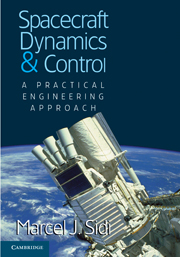Book contents
- Frontmatter
- Dedication
- Contents
- Preface
- Acknowledgments
- Chapter 1 Introduction
- Chapter 2 Orbit Dynamics
- Chapter 3 Orbital Maneuvers
- Chapter 4 Attitude Dynamics and Kinematics
- Chapter 5 Gravity Gradient Stabilization
- Chapter 6 Single- and Dual-Spin Stabilization
- Chapter 7 Attitude Maneuvers in Space
- Chapter 8 Momentum-Biased Attitude Stabilization
- Chapter 9 Reaction Thruster Attitude Control
- Chapter 10 Structural Dynamics and Liquid Sloshing
- Appendix A Attitude Transformations in Space
- Appendix B Attitude Determination Hardware
- Appendix C Orbit and Attitude Control Hardware
- Index
- References
Chapter 3 - Orbital Maneuvers
Published online by Cambridge University Press: 18 December 2014
- Frontmatter
- Dedication
- Contents
- Preface
- Acknowledgments
- Chapter 1 Introduction
- Chapter 2 Orbit Dynamics
- Chapter 3 Orbital Maneuvers
- Chapter 4 Attitude Dynamics and Kinematics
- Chapter 5 Gravity Gradient Stabilization
- Chapter 6 Single- and Dual-Spin Stabilization
- Chapter 7 Attitude Maneuvers in Space
- Chapter 8 Momentum-Biased Attitude Stabilization
- Chapter 9 Reaction Thruster Attitude Control
- Chapter 10 Structural Dynamics and Liquid Sloshing
- Appendix A Attitude Transformations in Space
- Appendix B Attitude Determination Hardware
- Appendix C Orbit and Attitude Control Hardware
- Index
- References
Summary
Introduction
From the moment that a satellite is launched into its initial orbit, commonly called a transfer orbit, multiple orbital changes must be performed. Changes of the transfer orbit are necessary in order to obtain the desired final orbit because a launch vehicle usually cannot put the satellite in its final orbit. Even if it were possible, a satellite launch that placed the s/c in its final orbit would not be optimal from the point of view of fuel consumption (see Duret and Frouard 1980).
Fuel consumption is a crucial factor in orbital maneuvers. Any orbital change is accompanied by a velocity change of the satellite, which necessitates a certain quantity of fuel consumption. As we shall see in this chapter, minimization of fuel consumption is essential because the weight of the useful payload that can be carried to the desired orbit depends on this minimization.
This chapter will also consider different kinds of orbit maneuvers and changes. For instance, orbits may be adjusted by single or multiple thrust impulses. It will be seen that with a single thrust impulse, very limited kinds of orbit changes can be achieved, whereas multiple thrust impulses can effect any desired orbit change. It is comparatively easy to analyze the change in orbit parameters due to an impulsive thrust; the analytical treatment usually ends with a closed-form solution. Unfortunately, an impulsive thrust is an idealization that cannot be met in practice.
Thus, another way of viewing orbital maneuvers concerns the duration of the thrust. During an orbit change, thrust is applied for a length of time (sometimes hours) that depends on the thrust magnitude (see Redding 1984). What we call an impulsive thrust depends very much on the thrust duration relative to the orbit's natural period. The principal drawback in applying a nonimpulsive thrust is that the application of a finite-time thrust is accompanied by a nonconstant thrust direction during burns. The nonconstant thrust direction results in a velocity loss because only a component of the thrust acceleration, rather than its entire value, acts along the mean thrust direction (see Robins 1966).
- Type
- Chapter
- Information
- Spacecraft Dynamics and ControlA Practical Engineering Approach, pp. 64 - 87Publisher: Cambridge University PressPrint publication year: 1997



